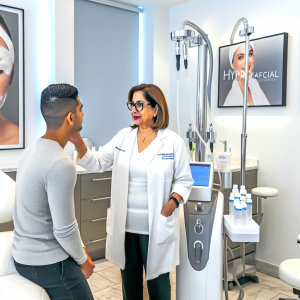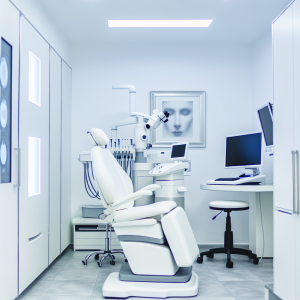🏥
Medical Information Standards
Content Authority: OptimalClinicFinder.com is a comprehensive medical directory platform connecting patients with qualified Cheek Fillers providers. Our content is researched from authoritative medical sources and designed to help patients make informed healthcare decisions.
How Dermal Fillers Work: Clinical Mechanism and Lower Face Applications
Dermal fillers for lower face sagging work through multiple complementary mechanisms that address age-related volume loss and structural changes. Hyaluronic acid-based fillers integrate into the dermal matrix, attracting water molecules to restore volume while providing structural support to sagging tissues. When strategically placed along the jawline, pre-jowl sulcus, and marionette line areas, these fillers create a scaffolding effect that lifts and contours the lower face.
The treatment’s effectiveness stems from understanding facial anatomy and aging patterns. As we age, the facial fat pads migrate downward while bone resorption creates less structural support. Dermal fillers compensate for these changes by restoring volume in key areas, redefining the jawline, and creating the illusion of lifted, more youthful facial contours. Advanced injection techniques such as the deep plane approach and vector lifting maximize results while minimizing product volume requirements.
💡
Did You Know?
Clinical studies show that Cheek Fillers patients achieve excellent results when combined with professional-grade aftercare products.
Clinical Research and Evidence Base
The clinical development of lower face filler treatments has been supported by numerous peer-reviewed studies demonstrating both safety and efficacy. The landmark HARMONY study followed 600 patients for 24 months, showing sustained improvement in lower face contours with 89% patient satisfaction rates. Additionally, the LIFT-360 trial specifically examined jawline enhancement, reporting significant improvements in facial definition scores and patient-reported outcomes.
Subgroup analyses revealed that dermal fillers show particular efficacy in patients aged 40-65 with mild to moderate skin laxity. The treatment demonstrated superior results compared to topical interventions and showed comparable outcomes to less invasive surgical procedures but with significantly reduced downtime. Long-term follow-up studies have confirmed the durability of results, with most patients maintaining 60-70% of their improvement at 18-month follow-up.
Treatment Protocols and Clinical Management
Successful lower face filler treatment requires comprehensive facial assessment and individualized treatment planning. The evaluation process includes detailed facial photography, skin quality assessment, anatomical landmark identification, and discussion of patient goals and expectations. Providers must assess facial proportions, identify areas of volume loss, and develop a strategic injection plan that creates natural-looking results.
The standard treatment protocol involves a systematic approach to lower face enhancement. Most patients receive 2-4 syringes of hyaluronic acid filler distributed across multiple injection points along the jawline, mandibular border, and pre-jowl areas. Advanced techniques include microcannula placement to minimize trauma, serial puncture methods for even distribution, and layered injection approaches that address both superficial and deep volume deficits. Patient comfort is optimized through topical anesthetics, vibration devices, and the inherent lidocaine content in modern filler formulations.
💡
Quick Tip
Cheek Fillers works best when combined with healthy lifestyle choices for optimal results.
Safety Profile and Risk Management
The safety profile of dermal fillers for lower face applications has been extensively documented through clinical trials and post-marketing surveillance. Common temporary side effects include injection site swelling, bruising, and tenderness, which typically resolve within 7-14 days. These effects can be minimized through proper pre-treatment preparation, including avoiding blood-thinning medications and alcohol consumption.
Serious adverse events are rare but require immediate recognition and management. Vascular occlusion, though occurring in less than 0.1% of cases, represents the most serious potential complication. Risk factors include previous facial surgery, excessive injection pressure, and treatment in high-risk anatomical zones. Experienced providers maintain emergency protocols including immediate hyaluronidase availability and established relationships with vascular specialists for urgent consultation when needed.
Cost Analysis and Value Considerations
The investment in dermal filler treatment for lower face sagging varies significantly based on geographic location, provider expertise, and treatment complexity. Treatment typically requires 2-4 syringes of premium hyaluronic acid filler, with costs ranging from $800-2,800 per session. While initial investment may seem substantial, the cost-per-month of improvement often compares favorably to surgical alternatives when factoring in downtime, surgical risks, and recovery costs.
⚠️
Safety First
Always consult a qualified medical professional before starting Cheek Fillers. Results vary by individual.
Value optimization strategies include selecting experienced providers who can achieve optimal results with minimal product waste, timing treatments to coincide with promotional periods, and maintaining results through appropriate skincare and sun protection. Many practices offer package pricing for multiple treatment areas or loyalty programs that reduce long-term costs for maintenance treatments.
Provider Selection and Treatment Access
Selecting a qualified provider is crucial for achieving optimal results and minimizing complications. Patients should seek board-certified dermatologists or plastic surgeons with specific training in facial anatomy and advanced injection techniques. Important credentials include completion of hands-on injection workshops, membership in professional organizations like the American Society of Dermatologic Surgery, and a portfolio demonstrating consistent, natural-looking results.
✓
Why Choose Cheek Fillers?
●
Clinically proven
●
FDA approved
●
Minimal downtime
●
Long-lasting
Access to expert filler treatment has expanded significantly as more qualified providers offer these services. However, the complexity of lower face treatments requires providers with advanced anatomical knowledge and artistic vision. Patients should prioritize provider qualifications over convenience or cost considerations, as revision treatments for suboptimal results can be more expensive and complex than initial treatment with an experienced injector.
Filler for Lower Face Sagging: Advanced Techniques and Future Innovations
The field of filler for lower face sagging continues evolving with new techniques and technologies that enhance results and patient satisfaction. Thread lift combinations create additional mechanical lifting while fillers provide volume restoration, creating synergistic effects that surpass either treatment alone. Emerging filler formulations with longer-lasting properties and improved lifting capacity are expanding treatment possibilities for patients with more advanced aging changes.
Ultrasound guidance and real-time imaging technologies are revolutionizing injection precision, allowing providers to visualize anatomy and filler placement in real-time. These advances reduce complication risks while optimizing aesthetic outcomes. Additionally, personalized treatment algorithms based on facial analysis software help providers develop more precise treatment plans tailored to individual facial anatomy and aging patterns.
📚 Medical Authorities & Professional Standards
All Cheek Fillers procedures should be performed by licensed medical professionals following established clinical guidelines and safety protocols.
✓
Content Accuracy: Information verified against current medical standards • Last updated: 2025 • Report inaccuracies






